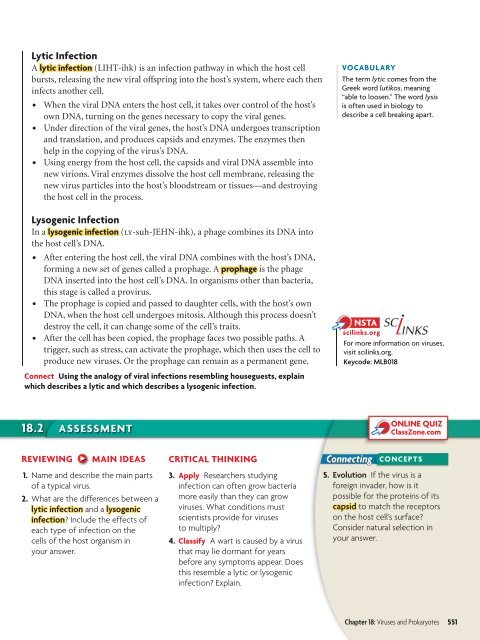18.1 Studying Viruses and Prokaryotes
18.1 Studying Viruses and Prokaryotes
18.1 Studying Viruses and Prokaryotes
You also want an ePaper? Increase the reach of your titles
YUMPU automatically turns print PDFs into web optimized ePapers that Google loves.
Lytic InfectionA lytic infection (LIHT-ihk) is an infection pathway in which the host cellbursts, releasing the new viral offspring into the host’s system, where each theninfects another cell.• When the viral DNA enters the host cell, it takes over control of the host’sown DNA, turning on the genes necessary to copy the viral genes.• Under direction of the viral genes, the host’s DNA undergoes transcription<strong>and</strong> translation, <strong>and</strong> produces capsids <strong>and</strong> enzymes. The enzymes thenhelp in the copying of the virus’s DNA.• Using energy from the host cell, the capsids <strong>and</strong> viral DNA assemble intonew virions. Viral enzymes dissolve the host cell membrane, releasing thenew virus particles into the host’s bloodstream or tissues—<strong>and</strong> destroyingthe host cell in the process.Lysogenic InfectionIn a lysogenic infection (ly-suh-JEHN-ihk), a phage combines its DNA intothe host cell’s DNA.• After entering the host cell, the viral DNA combines with the host’s DNA,forming a new set of genes called a prophage. A prophage is the phageDNA inserted into the host cell’s DNA. In organisms other than bacteria,this stage is called a provirus.• The prophage is copied <strong>and</strong> passed to daughter cells, with the host’s ownDNA, when the host cell undergoes mitosis. Although this process doesn’tdestroy the cell, it can change some of the cell’s traits.• After the cell has been copied, the prophage faces two possible paths. Atrigger, such as stress, can activate the prophage, which then uses the cell toproduce new viruses. Or the prophage can remain as a permanent gene.Connect Using the analogy of viral infections resembling houseguests, explainwhich describes a lytic <strong>and</strong> which describes a lysogenic infection.VOCABULARYThe term lytic comes from theGreek word lutikos, meaning“able to loosen.” The word lysisis often used in biology todescribe a cell breaking apart.For more information on viruses,visit scilinks.org.Keycode: MLB01818.2 ASSESSMENTONLINE QUIZClassZone.comREVIEWINGMAIN IDEAS1. Name <strong>and</strong> describe the main partsof a typical virus.2. What are the differences between alytic infection <strong>and</strong> a lysogenicinfection? Include the effects ofeach type of infection on thecells of the host organism inyour answer.CRITICAL THINKING3. Apply Researchers studyinginfection can often grow bacteriamore easily than they can growviruses. What conditions mustscientists provide for virusesto multiply?4. Classify A wart is caused by a virusthat may lie dormant for yearsbefore any symptoms appear. Doesthis resemble a lytic or lysogenicinfection? Explain.Connecting CONCEPTS5. Evolution If the virus is aforeign invader, how is itpossible for the proteins of itscapsid to match the receptorson the host cell’s surface?Consider natural selection inyour answer.Chapter 18: <strong>Viruses</strong> <strong>and</strong> <strong>Prokaryotes</strong> 551
















